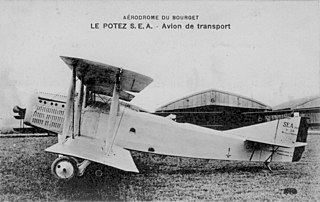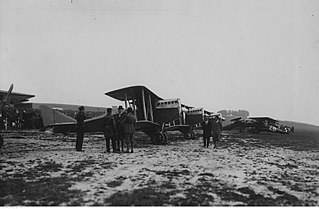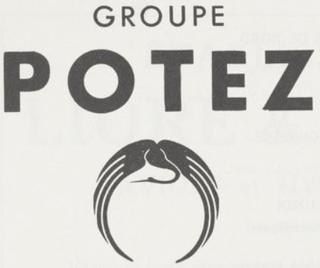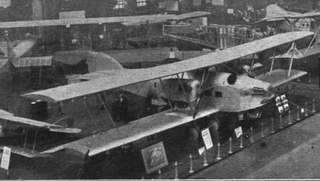
The SEA IV was a French two-seat military aircraft of World War I and the immediate post-war era.
The Société d'Études Aéronautiques (SEA) was a French aircraft manufacturer founded in 1916 by Henry Potez, Marcel Bloch, and Louis Coroller at Suresnes.

The Ansaldo A.300 was an Italian general-purpose biplane aircraft built by the Ansaldo company of Turin from 1920 to 1929. It also served as a light bomber, transport, fighter and reconnaissance aircraft, and finally as an advanced trainer, with examples in service as late as 1940. 50 examples were also license-built in Poland at ZM E. Plage & T. Laśkiewicz, but were not a success due to poor quality.

Potez 25 was a French twin-seat, single-engine biplane designed during the 1920s. A multi-purpose fighter-bomber, it was designed as a line aircraft and used in a variety of roles, including fighter and escort missions, tactical bombing and reconnaissance missions. In the late 1920s and early 1930s, Potez 25 was the standard multi-purpose aircraft of over 20 air forces, including French and Polish. It was also popular among private operators, notably mail transport companies.

Potez was a French aircraft manufacturer founded as Aéroplanes Henry Potez by Henry Potez at Aubervilliers in 1919. The firm began by refurbishing war-surplus SEA IV aircraft, but was soon building new examples of an improved version, the Potez SEA VII.
The Potez XV was a French single-engine, two-seat observation biplane designed as a private venture by Louis Coroller and built by Potez and under licence in Poland.

The Blériot-SPAD S.20 was a French fighter aircraft developed near the end of World War I. Too late to serve in the war, almost 100 of these aircraft equipped the French Air Force in the years immediately following. These agile aircraft were also used successfully for air racing and record-setting.

The CAMS 30E was a two-seat flying boat trainer built in France in the early 1920s. It was the first aircraft designed for CAMS by Raffaele Conflenti after he had been recruited by the company from his previous job at Società Idrovolanti Alta Italia (SIAI). It was a conventional design for the era featuring a two-bay equal-span unstaggered biplane wing cellule. The prototype was exhibited at the 1922 Salon de l'Aéronautique and evaluated the following year by the Aéronautique Maritime. The type's favourable performance led to an order of 22 machines for the French military and an export order of seven for Yugoslavia and four for Poland.

The CAMS 37 was a flying boat built in France in the mid-1920s that was originally designed for military reconnaissance, but which found use in a wide variety of roles in a large number of versions. It was the first design for Chantiers Aéro-Maritimes de la Seine (CAMS) by the company's new head designer, Maurice Hurel. The prototype was displayed at the 1926 Salon de l'Aéronautique in Paris. The prototype first flew in 1926, and after testing was ordered into service before the end of the year. It was a conventional biplane flying boat very similar to previous CAMS designs, being driven by a pusher propeller whose engine was mounted on struts in the interplane gap. The first production version was the amphibious CAMS 37A that was bought by the French Navy, the Portuguese Navy and the aeroclub of Martinique.

The CAMS 55 was a reconnaissance flying boat built in France in the late 1920s which equipped the French Navy throughout the 1930s.

The Potez 540 was a French multi-role aircraft of the 1930s. Designed and built by Potez, it served with the French Air Force as a reconnaissance bomber, also serving with the Spanish Republican Air Force during the Spanish Civil War. Although obsolete as a bomber, it remained in service in support roles and in France's overseas colonies at the start of World War II.

The Caudron C.109 was a light utility aircraft built in France in the late 1920s.

The Farman F.70 was a 1920s French passenger and mail transport aircraft designed and built by the Farman Aviation Works. It was a smaller counterpart to the company's popular F.60 Goliath. The F.70 was an unequal-span two-bay biplane with a wooden fuselage and was powered by a Renault 12Fe piston engine. The pilot was seated in an open cockpit behind the nose-mounted engine. Behind the open cockpit was a cabin for four passengers or freight.

The Potez 56 was a 1930s French executive transport monoplane built by Potez and later used as a military crew trainer and liaison aircraft.

The Nieuport-Delage NiD 30 was a French airliner which entered service in 1920. It was a conventional biplane design with an enclosed cabin that seated four passengers and an open cockpit for the pilot. Provision was also made for a wireless transmitter, receiver, and operator. Seven examples were operated by Compagnie générale transaérienne on its Paris–London route on twice-daily return services.

The Potez IX was an early airliner produced in France in the 1920s, a further development of the SEA IV that Henry Potez had co-designed during the First World War.

The Farman F.160 A.2 was a 1920s French sesquiplane designed as a military reconnaissance and observation aircraft. Only one was built.

The Potez VIII was a French training aircraft which first flew in 1920. Originally it had a very unusual vertical inline engine and a four-wheeled undercarriage, though the production version was more conventional.

The Potez XVIII was a French airliner from the early 1920s, a three-engine biplane carrying up to twelve passengers.

The SPAD S.42 was a French biplane trainer aircraft of the early 1920s, developed by Société Pour L'Aviation et ses Dérivés (SPAD) from prolific SPAD S.XIII fighter.


















